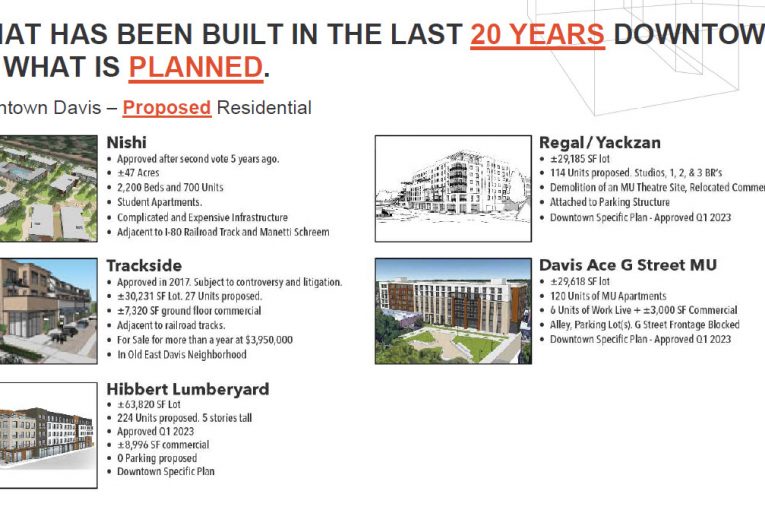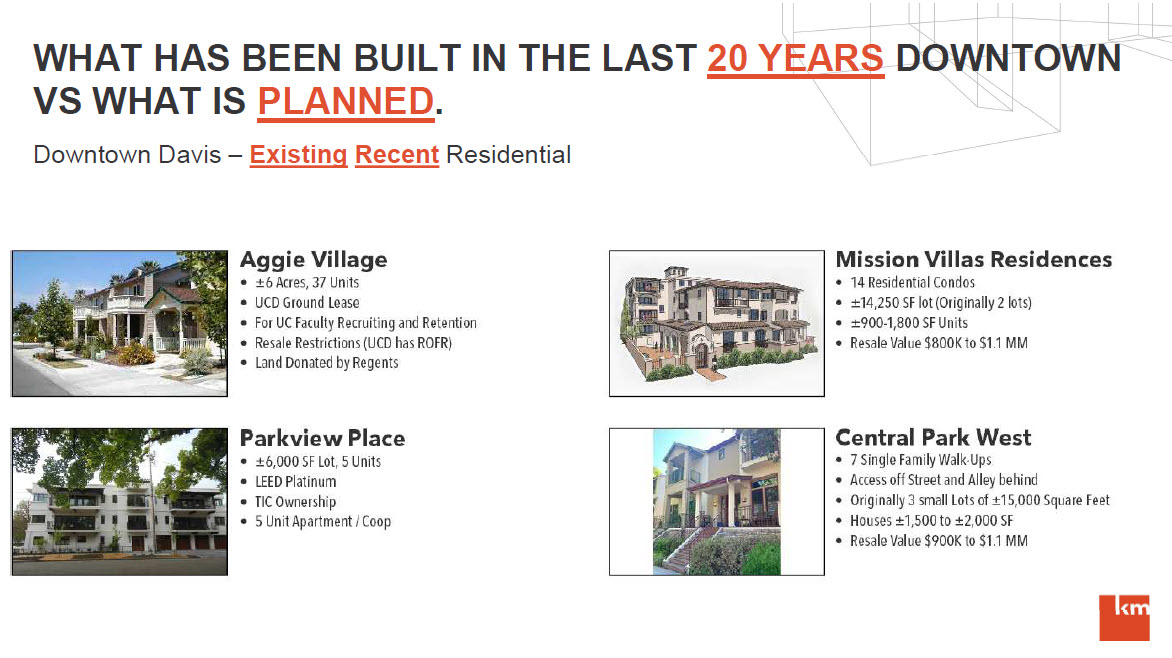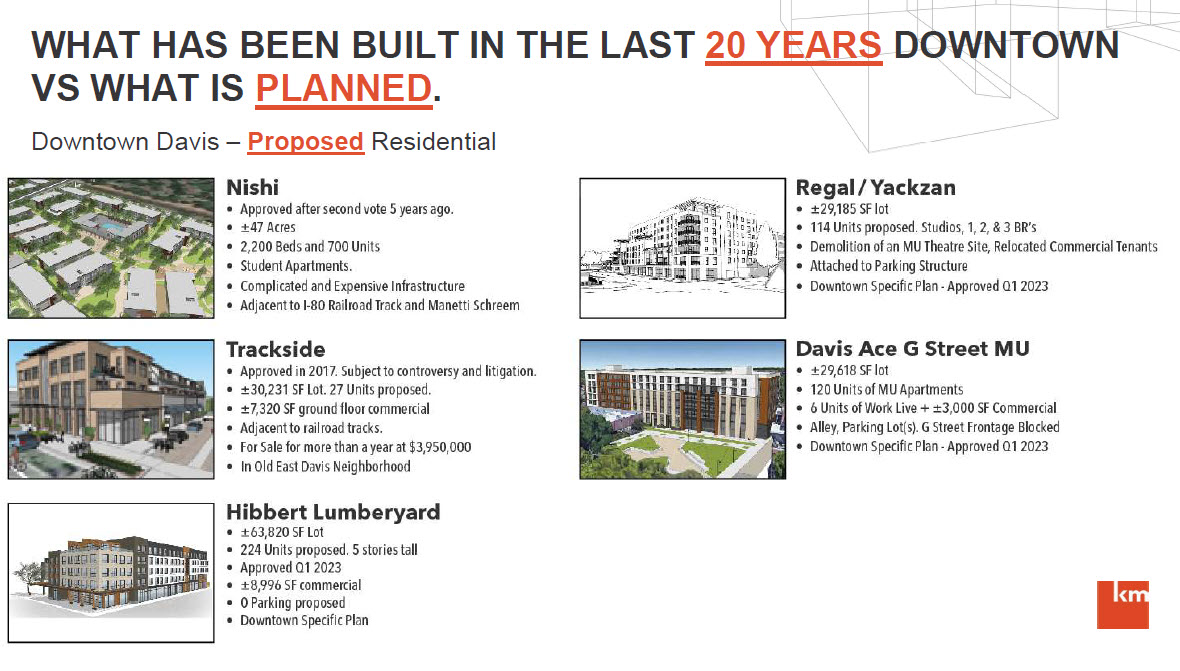
By David M. Greenwald
Executive Editor
Davis, CA – As I was doom scrolling on Facebook on Friday afternoon, I stumbled on a photo of Jim Gray, giving a presentation to the Sunrise Rotary on Friday morning. I reached out to him and he shared with me his slides, but also some interesting anecdotes.
These really stood out to me.

On the first slide is what has been built in the downtown area in the last 20 years. The short answer is not a huge amount. In fact, the four projects in the slide amount to just over 60 units. But they were ownership units.
 Flash forward to what has been planned in the downtown area now. You may not think of Nishi as being in the downtown, but it’s a very quick and easy walk from Nishi to the downtown.
Flash forward to what has been planned in the downtown area now. You may not think of Nishi as being in the downtown, but it’s a very quick and easy walk from Nishi to the downtown.
You basically have Nishi and Trackside which have been approved, but are on hold, and the three recent proposals.
There are a few key differences—whereas the small projects built were ownership units and relatively small in terms of number of units, what is being planned for the most part are large numbers of units, but all of them are apartments and rentals rather than ownership units.
That shift isn’t accidental and it’s not without consequences for the future of the community.
The city is facing a housing crisis. They are also feeling the pressure from the state to meet their compliance with their RHNA targets or face potential lawsuits and the loss of local control.
With Measure J, the city cannot rezone land outside of the city without a vote of the public. That is forcing the city to meet its RHNA numbers in this cycle with infill. To do that, they are not just relying on infill to do that, but large unit rental projects to make up for the lack of vacant land and inability to go peripheral.
This strategy is changing the nature of Davis because it is moving Davis away from building homes for families; instead, it is building rental housing which will trend away from families with children. Once again, this is putting pressure on our schools, as the housing we are building is not going to accommodate many families with children.
This is another example how attempting to hold onto to the status quo is actually driving fundamental change in our community.
These slides paint a very vivid picture of that change in focus in just the last few years, which is exacerbating an overall long-term trend.
But there is another unintended consequence—those worried about the fiscal health in the community might want to take note here.
Earlier this week, we broke the story of the letter from Legal Services. One of the points made in that letter is that the city is of out of compliance with the state on its Housing Element.
One of the ways it was out of compliance is that the city failed to complete its rezone obligation when the “the City failed to submit a compliant adopted housing element by its sixth cycle due date of May 15, 2021. This means that HCD cannot find the City in compliance with Housing Element law until it completes all rezones necessary to accommodate the shortfall of sites.”
Among the points made, “Housing Element Version 2 still includes the Brixmor/University Commons Project, but the residential component of that project has since been removed. The City must identify other sites to meet the shortfall.”
The city is facing pressure from the state and now with the letter from legal services, potentially from outside elements. And yet, the city still has yet to submit a revised housing element.
One constraint faced by the city is the lack of land available for rezoning. They acknowledge that, for next RHNA cycle, they are going to have to go peripheral, but in trying to avoid having to go to Measure J votes to get in compliance this time, they need to find land that they can rezone.
The Vanguard has learned that the city has reached out to commercial land owners for potential rezone.
While that might solve the city’s housing compliance problems, it will likely create new problems.
Those who worry about city finances should be alarmed by a few things. One was a discussion recently where the council essentially acknowledged that there was no actual requirement for mixed-use in the downtown—which means an all-residential project is potentially compliant with current zoning.
Second, any effort to convert commercially zoned land for residential is essentially robbing from Peter to pay Paul.
And third, Measure J itself is problematic in this respect. It treats commercial identically to residential—i.e. both need a vote to convert land outside of the city or zoned for agricultural uses.
Over the last 30 years or so, the city has prolonged discussions about the need to expand retail and the need to expand technology and innovation. None of those efforts have produced new projects other than perhaps Target.
Now the state is going to come in and put pressure on the city to add housing. While the city faces the same constraints on housing as it did retail and commercial development, the big difference is state pressure.
By the state pressuring the city to build more housing or face the consequences, the city is likely to prioritize housing over commercial. At one level, housing is needed and the city needs to build it. But it is going to come at the cost of commercial development that is crucial for city revenue and city finances.
There is no doubt that we need housing, but we need housing that fills critical niches and it should not come at the expense of city priorities such as revenue.


The city already has homes for families. It is not “moving away” from those.
The “problem” is those who believe that the purpose of a community is to serve the school system, and therefore must continue to grow as families age-out of the system. The people who think this way are an ongoing threat.
This is complete and total b.s. Totally fabricated, other than student housing due to UCD.
You (and those like you) supported the state takeover by YIMBYs in the first place. And now you’re complaining about them?
The assumption here is that the state treats cities like Davis “differently” than the vast population centers along the coast – which aren’t expanding outward. No evidence whatsoever has been presented regarding that assumption.
Well, there is University Mall, which some attempted to compromise with housing. But for the most part, retail is dead – not just in Davis.
(See San Francisco, for example – it’s in what some are calling a “doom loop” – both in terms of its downtown office buildings, and retail. It is in serious trouble. And unlike Davis, it’s a major city.)
Also, unfunded pensions are still an issue for cities across the entire state.
Cities are going to have to find another way. Workers aren’t returning, due to the ability to telecommute.
But have you considered trying one of them “DISC” type of developments?
Also, you (David) and those like you also supported housing students in the city, instead of on-campus. Students are the ones who will live in the downtown monstrosities, as a direct result of what you advocated for.
Whoosh.
We are taking about brand new retail, not to replace what once existed in Davis. Since you say retail is dead, the new University Mall will also wind up dead. After the City picks up the pieces of the disaster that Ron Oertel advocated for, that land can either remain vacant or be utilized as new housing.
It is surprising that Brixmor is willing to redevelop the mall. I suspect that the reason that Brixmor is willing to invest is due to students. That’s why Nordstrom Rack will work there.
I guess folks like the developer referenced in this article (who I understand is primarily a commercial developer) are claiming that the “devil made them do it”, in regard to abandoning commercial for residential? Though I don’t know if he’s involved with the downtown student housing developments.
What exactly did I advocate for? I am glad to see that Brixmor is willing to invest in the community. Have you told them of your “professional expertise” in regard to retail consulting, and that they’re wasting their money?
If it’s not already happening, cities need to get a “piece of the online action”, in regard to sales tax.
But yeah, retail is for the most part dead. Do you read anything other than the Vanguard, Walter?
https://www.kron4.com/news/bay-area/westfield-pulling-out-of-downtown-san-francisco/
I monitor dozens of sites on an almost daily basis. It’s not difficult if you know how. Maybe Roberta can give you some tips.
On July 13th you said this Ron. That looks like advocacy to me.
As I said, I’m glad that Brixmor is willing to redevelop the mall.
The comment you cited was written AFTER that decision was made.
The above lead paragraph for this article is put forth in typical Greenwald fashion, in regard to any background or reason that David contacted Jim Gray.
It is also not clear if Jim Gray is strictly a broker, or if he’s also a developer.
Retail vacancy rate in SF has gone from 4.8% (2022) to 5.8% (2023). The death of retail is always exaggerated and most people overestimate the level of internet commmerce (15.1% of retail in 2023, down slightly from 2020). Some retail sectors have been declining for years, as have some retail development models. But while malls are declining overall, there are successful ones and I think Brixmor will be very successful with the U Mall remodel primarily because they have a built-in, increasing market with the student demographic and the businesses who wish to sell to that market will be drawn to the new site. I’m sure there will be fine student-oriented eateries, and the Nordstrom Rack might succeed (track record for department stores there is mixed, but each previous iteration had its own special issues).
It’s too bad some housing couldn’t be included in this renovation; this is one case where I think it would have been a very successful project and would have been beneficial to the city. The issue is that the city was counting on those housing units and they clearly cannot any more.
That’s a distinction without a difference Ron.
Walter: I tend to think of advocacy as efforts made to influence a decision, not an observation made after-the-fact.
Like you did, when you asked YIMBY Law to consider suing the city.
Though I probably made some comments before the decision was made, I did not deeply care if the city chose to ruin that mall. I can also see the logic in encouraging housing at that site, even if it ruined the mall.
On a broader level, I’m sensing an increasing shift against the corporate-funded YIMBY shills. Not just on local blogs, but in major media sources such as The Chronicle’s comment section.
I’ve concluded that there really is no debating these people; they simply need to have power removed from them (state politicians, media, etc.). The time for debate was over before it even began. These people can’t even define what they mean by “housing crisis”.
I’d go further than that, and state that there never was a “problem to be solved” in the first place.
https://www.independent.com/2023/08/10/what-housing-crisis/
(This is my fifth and final comment allowed in this article for today.)
This is another distinction without a difference. On top of that, you are trying to change the subject Ron. That’s a common tactic with you.
Five comment rule is in effect for this article.
.
There are two fundamental factual problems with the statement above.
(1) The City cannot rezone land outside of the City under any circumstances.
(2) Measure J has absolutely nothing to do with that legal limitation under California Law.
The City has a sphere of influence beyond its boundaries over which it has planning control.